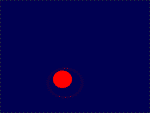
-- A Cyberspace Review Of The Arts
Volume 17.10
December 25, 2009
Editor:
Robert SievertEditorial Associates:
robert.sievert@gmail.com
Eva Sievert
Publisher and Webmaster:
ETAOIN / Gordon FitchArtezine is a New York City - based review of the Arts and Culture by artists for artists.
artezine17@etaoin.com
Editorial comments, contributions, and inquiries should be directed to Mr. Sievert.
Technical matters should be referred to ETAOIN (Eastern Technology Associates Inc.)
You can also write messages to the staff and contributors on our Messages page .
Permanent links to Artezine pages are best pointed to the archived version of any page including those of the current issue, since the index, contents and front pages of the current issue change from time to time.
All works, written, pictorial, musical or other, appearing in Artezine are copyrighted by their creator(s) unless otherwise indicated.
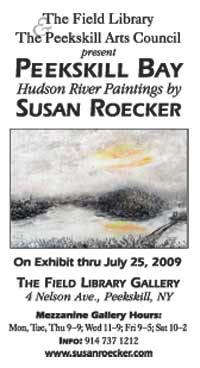
|
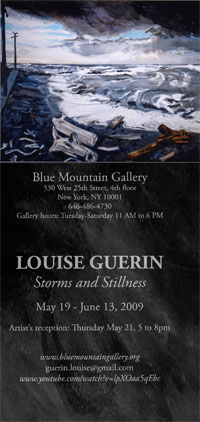
|
|
click on picture for press release 
|
|
Two Book Reviews 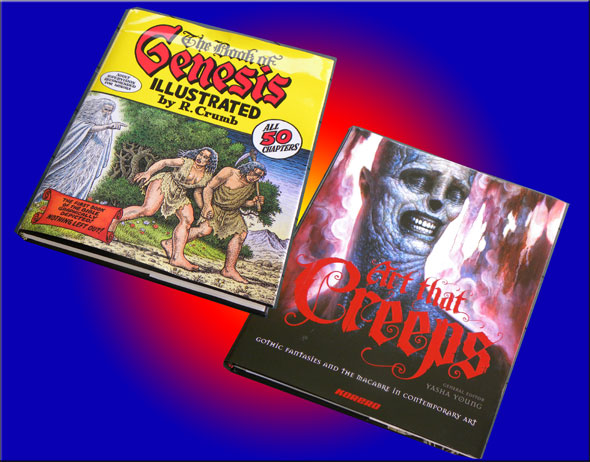
The Book of Genesis, Illustrated
Crumb's God is very clearly not some sort of religious or philosophical speculation but the literary character who shows up in the original Genesis, the Ancient of Days; he's an old but very vigorous man with long white hair and a flowing beard, a considerable aura, and impressive powers. (Crumb has said that drawing God required a lot of White-Out.) He is subject to fits of anger and crankiness and at least pretends not to be entirely omniscient or omnipotent, even if he is definitely the Creator. He has his doubts at times. Prior to the Flood, you will recall, he repents of having created humans, and resolves to destroy the world; but then he repents of his repentance as well and saves Noah: he changes is mind, which the more absolute post-Platonic God, beyond space, time, categories and reconsiderations wouldn't do. The original text is presented in completely unexpurgated and unmodified form, and thus includes individual murder, mass murder, annihilation of whole populations, rape, incest, violent sex perversion, fraud, robbery, war, and slavery, all of which are pictorially represented explicitly when necessary. The cover of the book recommends giving it to children only under adult supervision. Probably, though, it's not a lot harder than a lot of video games or the New York Post. Genesis is a tough, weird book just as the world is tough and weird, and Crumb meets it head-on with his eyes open. All the drawing is in the traditional Crumb style, but none of it, as far as I can see, is in the satirical or ironic mode. Crumb's fame, style and concerns began with parody of the lowest of lowbrow comics, including not only the ten-cent shoot-em-ups of his youth but also Tijuana Bibles and the stuff that became clip art, and to some extent his style still shows it; but in Genesis his more outrageous parodic excesses have been severely chastened. If we regard Genesis as Late Crumb and Zap Comix as Early Crumb, the bridge is clearly the middle period when various sketchbooks and autobiographical works appeared, in which Crumb made serious and I would say successful attempts to represent living and historical persons and things, such as famous Blues Musicians of the classical era, in a non-ironic, non-satirical and yet interesting development of his previous style. While these and the current work are no longer parody, they retain plenty of vigor and humor. One thing I expecially liked was that, confronted by endless lists of begats, where we have only names in the original Genesis, Crumb has gone to the trouble of drawing little portraits, each with personality, very possibly drawn from acquaintances or people seen in the street, reminding us that at least in theory the begat-lists were of real people, probably included because they were thought to be ancestors of the writers and transcribers. All of the characters, big and small, look like tough Middle Eastern tribespeople, not middle-class Americans as in so many sword'n'sandal movies, and they have those big Crumb hindquarters and feet. They're not delicate. On the whole, the book proved highly entertaining, and if you don't think it is quite up to the Sistine Chapel, at least it has more pages. I strongly recommend it.
Art that Creeps: Art That Creeps is a collection rather than the work of a single person. Unlike Genesis, then, it is a highly mixed bag. I found the title rather folksy given the content, some of which is quite serious. The blurbist on the back cover plays to the popular, as well: he or she writes "An amazing collection of neo-gothic visual energy and inspiration from the worlds of lowbrow, neo-surrealism and beyond." I take it this was a marketing decision, since "goths" and vampires are big with the ticket-buying folk these days, and should not reflect negatively on the contents. "Postmodern", it seems, is no longer considered a good hook.
|
|
|
ARCHIVE
|
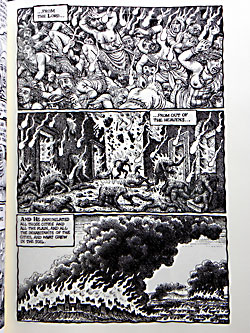 Just in time for Christmas, the famous or
perhaps infamous creator of Fritz the Cat
and Mr. Natural, Robert Crumb, has published
a book which radically departs not only from
his work but practically everone else's:
a comic (or graphic novel) of the Biblical
Book of Genesis, God and all.
Just in time for Christmas, the famous or
perhaps infamous creator of Fritz the Cat
and Mr. Natural, Robert Crumb, has published
a book which radically departs not only from
his work but practically everone else's:
a comic (or graphic novel) of the Biblical
Book of Genesis, God and all.
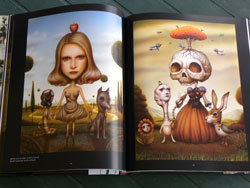 Horrifying, frightening, revolting or just plain
"creepy" work has of course been a component of
high art since antiquity, and includes such
redoubtable warhorses as Bosch, Blake, Goya, and
of course Francis Bacon. Recently, the demand for
the design of characters in science fiction,
fantasy and horror movies has spawned a crossover
milieu on the Internet in which mall rats with
corpses on their T-shirts rub along virtually with
prosperous gallery-goers who want something edgy as a
backdrop for their $500 haircuts. (Think of
Horrifying, frightening, revolting or just plain
"creepy" work has of course been a component of
high art since antiquity, and includes such
redoubtable warhorses as Bosch, Blake, Goya, and
of course Francis Bacon. Recently, the demand for
the design of characters in science fiction,
fantasy and horror movies has spawned a crossover
milieu on the Internet in which mall rats with
corpses on their T-shirts rub along virtually with
prosperous gallery-goers who want something edgy as a
backdrop for their $500 haircuts. (Think of
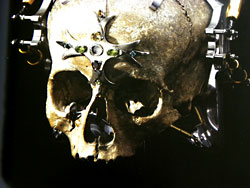 In this book, the media and styles are highly
variegated; one sees drawing, painting, sculpture,
photography, and combinations thereof. Some of
the material techniques are highly advanced. The
drawing and painting are, generally, strongly
realist in detail; overall the images
tend to be forthrightly surrealistic.
Some of the painting is more subtle,
perhaps expressionist more than realist (or "hyperrealist").
There are a few sculptures which, in
contrast to the painting, are not representative,
although they preserve the external texture of machines.
They are rather like something you might have
seen in a
In this book, the media and styles are highly
variegated; one sees drawing, painting, sculpture,
photography, and combinations thereof. Some of
the material techniques are highly advanced. The
drawing and painting are, generally, strongly
realist in detail; overall the images
tend to be forthrightly surrealistic.
Some of the painting is more subtle,
perhaps expressionist more than realist (or "hyperrealist").
There are a few sculptures which, in
contrast to the painting, are not representative,
although they preserve the external texture of machines.
They are rather like something you might have
seen in a
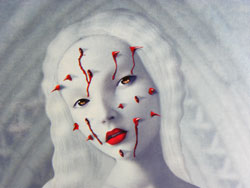 In most cases the work appears to be of a very
high technical quality, indeed, slickness, the
better to set off the overall strangeness or
"creepiness" of the work. I noticed that many of
the subjects are, or at least have begun as,
attractive young women; the signs of age, at least
of extreme age, are perhaps still too horrifying
even for goths and hyperrealists. There are not
many bug-eyed monsters, but there may be a few too
many skeletons. Dolls and creepy children, a
long-time staple of the form, are of course
not unrepresented. And in the realm of the
inescapable, I think we are given at least
one clown, but at least it is a subtle and
ambiguous clown.
In most cases the work appears to be of a very
high technical quality, indeed, slickness, the
better to set off the overall strangeness or
"creepiness" of the work. I noticed that many of
the subjects are, or at least have begun as,
attractive young women; the signs of age, at least
of extreme age, are perhaps still too horrifying
even for goths and hyperrealists. There are not
many bug-eyed monsters, but there may be a few too
many skeletons. Dolls and creepy children, a
long-time staple of the form, are of course
not unrepresented. And in the realm of the
inescapable, I think we are given at least
one clown, but at least it is a subtle and
ambiguous clown.
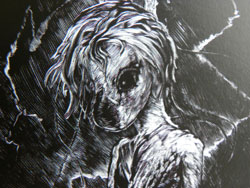 On the whole I felt quite entertained, one
might even say illuminateed, but not
deeply moved or provoked by the material in the
book. This is mostly work of a Baroque rather
than a Romantic or Classical sensibility, and like
early Surrealism appeals to the intellect rather
than the emotions or the spirit. For the most
part the images are beautiful or at least pretty
in the "gothic" mode, however, and
delightful to behold if your taste runs that
way.
On the whole I felt quite entertained, one
might even say illuminateed, but not
deeply moved or provoked by the material in the
book. This is mostly work of a Baroque rather
than a Romantic or Classical sensibility, and like
early Surrealism appeals to the intellect rather
than the emotions or the spirit. For the most
part the images are beautiful or at least pretty
in the "gothic" mode, however, and
delightful to behold if your taste runs that
way.
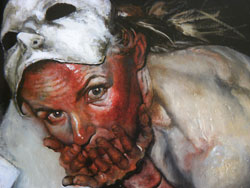 The names of the artists, some of whom I hope
to review as individuals some day, are
Jason Shawn Alexander, Wayne Martin Belger,
Annie Bertram, Marina Bychkova, Nicoletta
Ceccoli, Jan Czerwinski, Leslie Ditto,
Melissa Foreman, Naoto Hattori, Scott Holloway,
Avnia Kahn, Richard Kirk, Vera Mar, Michael
Page, Chris Peters, Michael Ryan, John Santerineross,
Natali Shau, David Stoupakis, Daniel Van Nes, Raf
Veulemans, Madeleine Von Foerster, Chet Zar. They
are mostly from North America or Western Europe;
an excursion into other geographical or cultural
realms might have been rewarding. (Latin America
in particular has earned some repute for this sort
of thing.) The editor is Yasha Young, of the
The names of the artists, some of whom I hope
to review as individuals some day, are
Jason Shawn Alexander, Wayne Martin Belger,
Annie Bertram, Marina Bychkova, Nicoletta
Ceccoli, Jan Czerwinski, Leslie Ditto,
Melissa Foreman, Naoto Hattori, Scott Holloway,
Avnia Kahn, Richard Kirk, Vera Mar, Michael
Page, Chris Peters, Michael Ryan, John Santerineross,
Natali Shau, David Stoupakis, Daniel Van Nes, Raf
Veulemans, Madeleine Von Foerster, Chet Zar. They
are mostly from North America or Western Europe;
an excursion into other geographical or cultural
realms might have been rewarding. (Latin America
in particular has earned some repute for this sort
of thing.) The editor is Yasha Young, of the